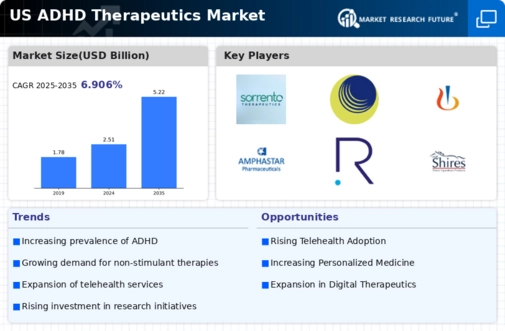The US ADHD Therapeutics Market is characterized by a dynamic competitive landscape, driven by the increasing prevalence of Attention Deficit Hyperactivity Disorder among both children and adults. This market is marked by a multitude of pharmaceuticals that are continually evolving to meet the diverse needs of patients. Key players in the industry focus on developing innovative treatments that address not only the core symptoms of ADHD but also the co-occurring conditions that patients often experience.
Companies are investing heavily in research and development to enhance drug efficacy and safety while also navigating regulatory requirements. The competitive insights reveal a blend of established pharmaceutical giants and emerging biotech firms that strive to capture their share of the growing market by leveraging unique therapeutic approaches and strategic partnerships.
Sorrento Therapeutics is positioned as a notable player within the US ADHD Therapeutics Market, with a strong commitment to addressing the therapeutic needs of ADHD patients. The company leverages its expertise in biotechnology to develop novel treatments aimed at improving patient outcomes. With a focus on innovation and personalized medicine, Sorrento Therapeutics has carved a niche through proprietary technologies that enable the design of tailored therapeutic solutions for ADHD.
Its strong pipeline of drug candidates demonstrates the company's dedication to advancing treatment options and enhancing the quality of care for individuals with ADHD. Sorrento Therapeutics' strategic focus on patient-centric therapies and its ability to adapt to the evolving market dynamics underline its competitive strength in this therapeutic area.
Supernus Pharmaceuticals is another significant entity in the US ADHD Therapeutics Market, recognized for its strong portfolio of ADHD medications that cater to both pediatric and adult populations. The company's flagship products include formulations aimed at optimizing treatment adherence and minimizing side effects, which are critical factors in the management of ADHD. Supernus Pharmaceuticals benefits from a solid distribution network and established relationships with healthcare professionals, enhancing its market presence and accessibility.
Additionally, the company consistently invests in research and development to expand its product lineup, reflecting its commitment to innovation and growth. Recent mergers and acquisitions have also strengthened Supernus' capabilities, enabling it to broaden its therapeutic offerings and maintain a competitive edge in the overall ADHD treatment landscape within the US. Its strategic focus on developing effective and well-tolerated medications positions Supernus Pharmaceuticals as a key player in addressing the challenges faced by ADHD patients and their caregivers.





















